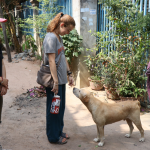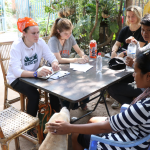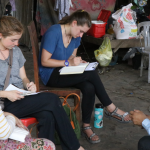By Karyn Simpson
Medill Reports
SIEM REAP, Cambodia – “There’s a dog!”
We moved closer to the house and waited patiently for the dog’s barks to bring its owner out to the street – a routine we’d perfected over 10 days of interviews. We learned quickly that, when trying to talk to dog owners in Siem Reap, Cambodia, finding a dog and letting it sound the alarm proved to be the most expedient way to bring its family outside to speak with us.
Finding a dog in Siem Reap’s Svay Dangkum Commune isn’t hard. Overpopulation of dogs is a major issue in the area, and dogs seem to be everywhere – trotting down the orange dirt road in front of us, peeking out from storefronts, napping under tables and digging through the informal garbage dumps that build up on street corners. Some of these dogs belong to owners – residents often let their dogs roam free, as opposed to locking them in a yard or walking them on a leash like “barangs” (western dogs). Some of the dogs that wander the commune, though, are strays or street dogs who must take care of themselves.
But why are there so many dogs, and what can be done to combat overpopulation and improve the health and welfare of both house pets and street dogs in Siem Reap? The matter could be as simple as increasing education and awareness about medical care and sterilization, preliminary research from The School for Field Studies suggests.
“We’re looking a lot at perceptions of dog ownership in Siem Reap, so how that plays in with sterilizations and vaccinations and overall dog welfare,” said Brenna Prevelige, a rising senior from Bucknell University. “There’s a pretty large overpopulation of dogs right now, which causes a lot of ecological and social threats to humans. So we’re trying to kind of understand perceptions and attitudes towards dogs in order to understand how to best address that problem.”
To do so, Prevelige and fellow researcher Monika Metro, a rising senior from Virginia Wesleyan University, spent 10 days walking up and down the twisting, red dirt streets in Siem Reap’s Svay Dangkum Commune searching for dogs and the families that owned or took responsibility for them. Metro and Prevelige spent the semester at The School for Field Studies in Cambodia, a study abroad program that culminates in a directed research project where students perform primary environmental research under the direction of an SFS faculty member – in this case, Megan English, Ph.D., a resident lecturer in conservation science. The Cambodia center is one of 10 SFS locations worldwide.
In the end, Metro and Prevelige spoke with 35 dog owners about how they take care of their dogs. “Do you feed your dog?” Typically, the answer was yes, dogs are fed with leftover rice and meat, though one exception is Kiki, the very big, male Shepherd mix that is allegedly a very picky eater and likes milk to be included with whatever he eats. Other questions included, “Is your dog sterilized?” (owners overwhelmingly answered with a “no”), and “Is your dog considered a member of the family?” (Almost everyone said “yes.”)
“We’re also trying to look at the welfare of the dogs – specifically household dogs – and how the households are taking care of them,” Metro said. “What type of medical care they’re providing the dog, what type of non-medical care they’re providing the dog with, and with that, where they’re getting their medical care and is it appropriate protocol.”
These questions served to give Prevelige and Metro not only an inside look into how dogs in the community are perceived, but also how they are treated and what cultural or community practices might be influencing use of formal medical care or giving rise to hesitations surrounding sterilization, which could contribute to the overpopulation.
What they found was a community that overwhelmingly loves dogs – 91 percent of interview respondents said their dogs were part of their family, according to the research analysis – and they are doing what they believe is right for them. But the lack of education about medical treatments and sterilization limits their choices.
For example, while one of the most effective ways to limit the dog population would be to encourage sterilization, 91 percent of the 52 dogs assessed were not sterilized, according to Metro and Prevelige’s research analysis. And 63 percent of respondents said they would not sterilize their dogs, even if given the opportunity. Some respondents attributed this to religion, while some argued that they wouldn’t want the same procedure performed on them – so they don’t want it done to their dogs – or that they just wanted their dogs to live freely, happily and naturally.
“We found that people were not interested in sterilization,” English said. “This comes down to Buddhist beliefs in a lot of respects, in that they want the animal to live a full life and enjoy [life] like a human would.”
While many respondents did attribute this hesitation to Buddhist religion, some Buddhist monks actually support sterilization events at their monasteries as a way to improve quality of life for the dogs and help slow population growth, English said. Based on this, any future efforts to encourage sterilization in the community would likely be best received if it came from the monks themselves, English, Metro and Prevelige all said.
Misinformation about sterilization added to people’s hesitation.
“They also perceived it to hurt the dog a lot,” Metro said. “I think they’ve seen other dogs go through sterilizations and go through a lot of pain and infections, so they thought that if they put their dog through the same thing, it would also go through pain.”
This seemed to extend to general medical treatments and practices as well. While 54 percent of respondents said they did take their dogs to the vet when problems arose, 29 percent said they treated their dog themselves with the human painkiller Paracetamol (Tylenol), for example. They used this for a variety of conditions, including when the dog was “throwing up, not eating or injured,” according to the research analysis. Though these dog owners meant well, Paracetamol is dangerous to dogs and can be deadly.
“A lack of proper care threatens dog welfare and indicates a larger issue of education and implementation of veterinary practices,” Metro and Prevelige wrote in their research analysis.
On the other hand, respondents were generally receptive to the idea of vaccinating their dogs, likely because “they do not consider [vaccines] to be altering the health or reproductive status of the dog, which was often considered immoral or against Buddhist beliefs,” Metro and Prevelige wrote in the analysis.
“Further studies should examine interest in vaccination events for dogs,” specifically to protect against rabies, Metro and Prevelige wrote in their analysis. While one of the original aims of this study was to gauge interest in sterilization – not vaccinations – English said she plans to look into the possibility of working with NGOs to give community members the option to get their dogs vaccinated during events at monasteries in Siem Reap.
“We saw interest in vaccination was high, even though we weren’t really asking for that,” Prevelige said. Increasing the number of vaccinated dogs could be a way to improve the general health and welfare of the dogs in the community.
This project, which built on a 2018 study of dog welfare and perception in rural Cambodia, was conducted with support from the Svay Dangkum Commune authority and Sala Kanseing village authority, representing the study site where Metro and Prevelige interviewed people. The information will be shared with community leaders to help formulate what can be done to slow population growth and improve overall health and welfare.
While this was student research, meaning that it hasn’t been peer reviewed and more data collection is necessary to gain a complete understanding of the issue and how to move forward, Metro and Prevelige hope that their results can be used to “determine future steps of dog population management and veterinary practice in Cambodia,” they wrote in their analysis.
“Our hope is that our project will help to spread awareness and education,” Metro said. “Even if NGOs can take the research we’ve done on perceptions and try to implement it.”














(Kary Simpson/MEDILL)


